Emergency Planning
2012-08-19; Four Essentials
Here we are coming up on the peak of hurricane season. I stumbled
across this
web page from Allstate Insurance. In a nutshell it says that
the four essential emergency supplies that you need to stock up on
are;
- Fuel
- No-Cook Foods
- Lights and Batteries
- Water
No argument there!
2012-07-04; Road Food
This post will cover food preps for emergencies, factoring in both a
"bugout" scenario and shelter-in-place scenario.
When emergencies loom, its a natural instinct for people to run to
the grocery store and stock up. What people buy in such situations
can be amusing. In areas that normally have little or no snow in the
winter, an impending snowstorm often results in supermarkets being
cleaned out of milk, bread, beer, hot chocolate, and toilet paper.
That doesn't really add up to a healthy diet. Plus, if ice takes out
the electrical power lines serving your neighborhood, that hot
chocolate mix isn't going to do you any good unless you have an
alternate means of boiling water. So what factors should you
consider when buying emergency supplies? Here are some
considerations:
- Food should be appropriate for the time of year. Ideally, it
shouldn't go bad in any weather. Stuff shouldn't melt in the
summertime, nor decompose due to high humidity. Nor should it
require real cooking in the wintertime, nor freeze and split
open.
- At least some of the food should be safe and convenient to eat
while driving.
- Most or all of the food should have a reasonable shelf life,
at least one year and preferably several years.
- If at all possible, your diet during an emergency should be
similar to your normal everyday diet.
- The food should be something you're willing to eat under
normal circumstances.
If your main emergency threats occur during warm weather, there's
no point in having several loaves of plain white bread on hand. As
soon as the power goes out and the A/C stops, that bread will
start turning to unpalatable mush. Likewise, how long will that
gallon of milk last in 95 degree heat? I don't see the point of
dodging hurricanes or tornadoes and then getting a bad case of
food poisoning. Your emergency food stores should not need
cooking, in my opinion. Electricity and possibly natural gas may
be out, and fire is pretty risky when the fire department cannot
come. Do keep in mind that stuff like canned soup can be eaten
cold if necessary. There's a strong temptation to go heavy on
comfort foods like canned chili, beans, Spam, etc. I used to do
that, but now I think its a bad idea. Your sodium intake will
already be spiking, and then you're adding abnormally salty food
(especially Spam). Plus, you may end up in close quarters with
others, likely without A/C, and eating gassy foods that will
probably cause loose bowels. That latter point dovetails in with a
future post on toiletries and first aid kits.
What I recommend in terms of foot storage management is to keep a
separate food box, and replace its contents annually. Since I live
on the edge of hurricane country, I try to remember to replace my
food preps annually in June, which is the official start of
hurricane season in Virginia. The food items in the box are moved
into my kitchen cabinets and consumed as part of normal
operations. I use a permanent marker to write the year and month
of purchase on each item. Most boxed and canned food has a "best
by" date stamped on it somewhere, but those markings can be hard
to read and its a ton of work to back out when it was purchased
(and thus when it should be replaced).
Here are some photos of the current contents of my food box;
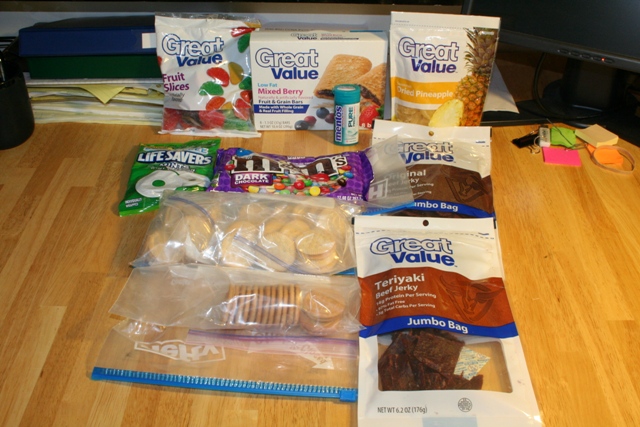
Above are the "road food" items that I can eat while driving. Beef
jerky, dried fruit, M&Ms, granola bars, cookies, and candy that
won't melt. In my humble opinion, M&Ms are the ultimate
emergency candy. They don't cause a mess in the summertime, don't
freeze and split in the wintertime, and are easily dispensed from a
bag. Observe that there are some peanut butter sandwich-type cookies
in those Ziploc bags. They've been tested in summer heat and don't
degrade. I have removed them from their original packaging and put
in several quart-sized Ziploc bags, and then re-bagged two
gallon-sized Ziploc bags. This protects them from going stale (and
bug infestation). Before starting the truck and heading down the
road, I can take one bag of cookies and put it within reach of the
driver's seat. Note that some food items don't have a re-sealable
box or bag, so bringing a box of quart-sized Ziploc bags is wise.
An added benefit of the beef jerky is that you can break it up or
cut it up and add it to instant soup and bouillon, if you have the
ability to boil water. That will add some protein, flavor, and
texture.
Note that the granola bars also cover breakfast, and provide a few
vitamins. Also note the little plastic container of Mentos chewing
gum balls. This is a good way of keeping your teeth somewhat clean
in abnormal circumstances. I like that kind of package because it
doesn't involve all sorts of fussy packaging (i.e. litter), and can
be easily manipulated while driving. Likewise, the package of
LifeSavers candy will help keep your breath tolerable.
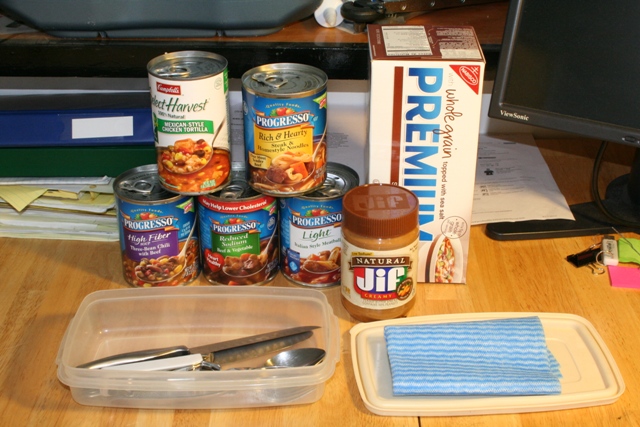
The above photo shows lunch and dinner food, along with some
silverware. Note that all of the soup cans have an easy opening top.
It is smart to bring a can opener or multitool (i.e. a Leatherman
multitool), but try to avoid buying canned food that requires
a tool to open. These foods provide carbs, protein, fats, and some
minerals and vitamins. Not a lot of fiber, unfortunately. Note that
I have a synthetic washcloth that I can use to clean the silverware.
Also, one of the knives is a typical dull table knife, but the other
one is a small chef's knife. Its always smart to have a real knife
for cutting up food. You may end up dropping anchor somewhere that
you can buy fresh groceries on a daily basis. The lid of that
plastic tub can be used as an impromptu cutting board for tomatoes
and the like.
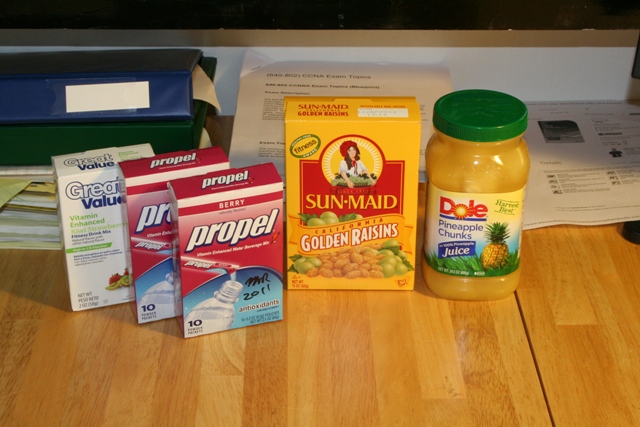
The above photo shows dried and canned fruit, and powdered drink
mixes. I tried using the small lunch-sized "cup of fruit"
containers, but I found that they just weren't airtight enough and
would spoil after a few months. Canned fruit is a great source of
Vitamin C and fiber. For drinks, I generally prefer sports drinks
like Propel rather than Gatorade. Gatorade is both sugary and salty,
which is great if you are playing football in the summer but
otherwise not so good. Propel has some vitamins and uses artificial
sweetener. Note that I've since replaced those boxes of Propel mix.
Those boxes have little plastic tubes of mix, sized to make a 16
fluid ounce drink. Much cheaper than buying bottled Propel, though
obviously you'll need a source of potable water and a reusable drink
bottle.
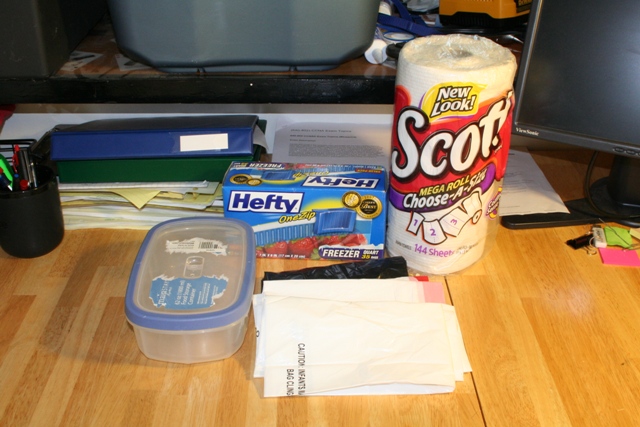
The above photo shows food-related items kept in the food box. The
empty plastic tub can be used to house and protect one day's worth
of driving food. The quart-sized Ziploc bags are useful for storing
food in an airtight fashion. Paper towels are obvious, and some
kitchen-sized trash bags should help keep your vehicle and whatnot
clean. I probably should add some sort of "wet-naps" or something
for hand cleaning, and wiping down the steering wheel and other
touch surfaces that I might get sticky food residue on. In previous
years I had a plastic container of those antiseptic hand wipes, but
they dried out rather quickly.
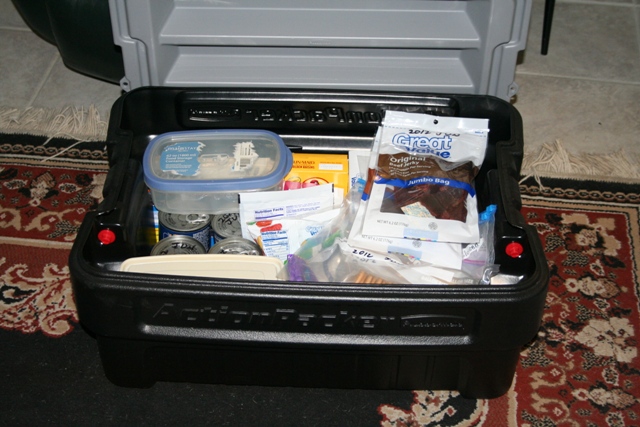
Here is a photo of my food box, ready to go. Keep in mind that I am
preparing for just me; if you have multiple ravenous teenagers, you
have a challenge an order of magnitude larger. The box itself is a
Rubbermaid ActionPacker, I forget which size. I'll guess that it is
an 18 gallon box; I'm not sure if they still make that particular
size. They are nice, but have gotten really expensive in the last
few years, even when Walmart carries them. Observe that the lid is
quite thick and is designed to take a load, so the box won't
collapse if stacked with other boxes and crates. This means you can
use it, carefully, as a seat if you find yourself in a camping
situation. They are lockable, with two padlocks. Its wise to leave
some room in your food box, in case you are able to add to it on the
road. And make sure you can comfortably lift and carry it when it is
full. If there is any doubt, go to two smaller containers. Note that
canned food is really heavy; after all, it is essentially canned
water, and water is over 8 pounds per gallon. In a future post I
will cover my "camp box" which contains non-food items. That box is
also a Rubbermaid ActionPacker, probably a 24 gallon model. Were it
not for the expense involved, I would be tempted to replace the two
large boxes with six 8-gallon ActionPackers just to make things more
convenient. The main advantage to two big boxes is that I can
quickly tie them down in my truck bed if I need to; I plan to avoid
doing that due to the risk of theft. Plus, I'm skeptical that they
will keep their contents totally dry in a heavy rain with gusty
winds.
You may be tempted to simply use a cardboard box for your food
stores. I am against that, for several reasons. One is simply that
most cardboard is crappy stuff, and will break down under load,
especially in humid weather. It will definitely break down if it
gets rained on, or if some container of liquid splits open and soaks
the bottom. And thirdly, cockroaches love corrugated cardboard. Not
only can they eat the glue that sticks the layers together, the
little air channels are used by female cockroaches to house their
young. So go with wood, plastic, or metal if at all possible.
I have a big truck, so this size of box is no big deal. If you drive
a compact or subcompact car, I think you'll find that you'll need to
break up your food stores into smaller bunches and pack them into
nooks and crannies in your vehicle. Still, I think its wise to keep
your emergency supplies centralized in your home; when you pack your
vehicle, you can break things down into smaller, packable bundles.
And that brings me to one of the more important points. The shelf
life of food depends very strongly on the storage conditions. The
"best by" date assumes that the food is kept at a moderate, constant
temperature; i.e. somewhere between 65 and 75 degrees, and fairly
constant. There's a temptation to keep emergency supplies in the
garage, attic, basement, or garden shed. I think this is a bad idea.
If at all possible, keep your food supplies in your "conditioned
space", i.e. where your normal interior heated and cooled air is.
Lastly, observe that I haven't covered drinking water and drinks
yet. That is a major topic by itself, that I will cover in a future
post.
I haven't done the math yet, but in 2012 prices we're looking at
maybe $40 for the storage box, $30 for the durable goods (plastic
tubs, silverware), $10 for the non-consumables (paper towels, Ziploc
bags), and under $100 for the food. Amusingly, the beef jerky is the
pricy element. The non-consumables will last one or more decades, so
on a dollars per year basis we're talking about less than $10 per
year. The consumables seem expensive, but using my system you'll eat
them when they get rotated out of your food box and into your normal
daily diet, so your expenditures will be offset by lower grocery
bills otherwise. Contrast this with just driving away with your
wallet; eating out 2 or 3 meals a day will get brutally expensive.
2012-06-06; The Percentage Game
Looking at prior disasters, and having a basic understanding of
human nature, one thing that becomes obvious is that authorities
become concerned with statistics rather than individuals. If an
official is dealing with a crisis which may result in a death rate
of 10%, he/she will be overjoyed if actions can reduce that rate
to 1%. In modern life, we tend to go along with the belief that
every person is unique, special, priceless, etc. And we are used
to businesses and government agencies dealing with us as an
individual. It appears to me that such conditions disappear in
crises.
What does that mean? In the context of emergency planning, the
main point is that you should think about and accept the idea that
in such circumstances, both private individuals and government
workers are going to treat people in bulk. Hopefully this leads
into planning to take care of yourself, rather than relying on
someone else to take care of you. The mayor and governor may be
thrilled to keep casualties down to 0.1% or 0.01% of the
population, but you have the incentive and opportunity to keep
your own personal casualty rate down to 0% via planning and
decisionmaking.
2012-06-06; Private versus Public Shelter
When disasters hit, one resource that is usually available to some
extent is that of public shelters. Its not uncommon for local
governments to turn high school gymnasiums into public shelters,
using folding cots or mats for bedding. You probably recall that in
the wake of the Katrina hurricane, residents of New Orleans who
stayed in town were urged to go to the Superdome. That was almost
certainly the worst-case scenario; 20,000 people stuffed into only a
few acres, little or no power, a partially compromised roof, weak
law enforcement, no health care, etc. The opposite outcome was the
use of what was then called Qualcomm Stadium, home to the San Diego
Chargers NFL team, to house the refugees of the 2007 wildfires. That
disaster and response was remarkable in how effective local
government and private organizations were in dealing with thousands
of refugees. That outcome was not accidental, as the 2007 wildfire
response enjoyed reliable electrical power, water, and sewage; and
the city had experienced a rehearsal of sorts due to wildfires in
2003, during which refugees descended on an unprepared stadium.
But even in smaller cities, there are many problems that can occur
in public shelters. From what I have read, theft is pretty common;
this is particularly important if you have critical medications, as
theft of prescription drugs is now a top priority of thieves and
burglars. And it doesn't matter whether your meds can provide a
"high" or not; if its in a prescription bottle, its gone. Another
thing to consider is the loss of personal freedoms. You simply won't
be allowed to go where you want to go, or do what you want to do.
Most Americans will find that intolerable and extremely stressful.
Another thing to consider in an open-area shelter is that you will
be exposed to all sorts of infection. Put a few hundred people in
close quarters in one big room, with only one or two working
restrooms, no hand soap or paper towels, etc. and its not hard to
imagine colds, various influenzas, bacterial and fungal infections
running wild. Lastly, if you are the responsible type and have
canned food, water, paper towels, toilet paper, etc., you can expect
it to be confiscated and "shared". This is no big deal if you have
money to spare, but if your house is gone and you can't get at
what's left of your checking and savings accounts, what you've
brought along may turn out to be a substantial portion of your new
net worth.
So the morals to the story are:
- either bug out early enough to find private lodging in a
motel, campground, with friends or family far from disaster, or
- build your house up enough to be livable after the disaster,
with enough stores to last you several weeks.
Doesn't the first approach sound a lot easier?
2012-06-01; Quick, Off-The-Cuff Observations on "Bugging Out"
Some important points for those planning to bug out in advance of a
storm;
- When bugging out, early is better, and farther is better.
- Keep your gas tank at least half full at all times!
- Plan on filling up at least 3 days before the storm hits.
- Know how far your vehicle will travel on a half tank of gas,
under normal traffic conditions.
- Since most dangerous weather occurs in the warmer half of the
year, your bugout vehicle must have a tip-top cooling system and
air conditioner.
- If you have pets and are going to bring them along, have a
plan for where you're going to go. It is extremely difficult to
find lodging if you have pets, and the authorities always seem
to have a strong urge to shoot pets. Bring a cage/crate if at
all possible. Also bring vet records. Authorities tend to assume
your dog is rabid, or worse.
- Get cash from your ATM at least 3 days in advance. ATMs run
out of cash before crises, and often don't work afterwards.
- Make sure you have plenty of working room on your credit
cards, several days before the storm.
- Have a 12 volt charger for your critical electronics
(cellphone, tablet PC, etc.). It may be days before you have
access to a wall socket.
- Bring your backup drive(s) for your home computers. If your
house is wiped off the map, the more records and info you have,
the faster you will be able to recover. Think especially of
stuff like family photos, resume & career records, and
finances.
2012-06-01; Quick, Off-The-Cuff Observations on "Bugging In"
Note the numerous problems with bugging in, described in the
hurricane stories presented in the links below. Flooding,
debris-blocked roads, downed power lines, complete lack of fuels,
violent crime, looting, etc. My conclusion is that the vast
majority of people would be better off bugging out. Some people
did pretty well surviving hurricanes Katrina and Rita using a
bug-in approach. AFAIK, they were all in rural or exurban areas,
away from Interstate freeways and major highways, and where their
neighborhoods had an existing community and residents who were
responsible and well-prepared. Not many of us live in such
conditions!
One of the themes that recur in post-hurricane stories is that of
keeping a low profile. I think that's very hard to do for the
average person, much less the average family. As an example, there
is someone who lives down the road from me that has a generator
configured to auto-start after power failures. I am going to guess
that the homeowner has some medical condition that requires an
electrically powered machine to run 24/7. When there have been
power failures at hours when there is little road traffic, that
generator can be heard from a quarter mile away. If you're one of
the few folks in the neighborhood that has long-running lanterns
of any sort, it will become pretty obvious. Being one of the few
who has prepared for disasters can attract all sorts of problems.
There is a local town that lies on the water, and is on land that is
very low (within its city limits, I think the highest point is only
about 10 feet above sea level, and mostly about 5 ft.). Some years
back when a tropical storm passed through, the storm surge
fortuitously arrived during a relatively low tide, so there were few
issues of flooding (aside from the usual consequences of 3+ inches
of rainfall). But there were still serious problems in many areas
due to downed trees. Some trees squashed otherwise unharmed houses,
other trees blocked roads. There were several hundred people who
could not leave their neighborhoods until the authorities came, many
days later, with heavy equipment to cut up and move massive oaks and
pines that blocked the roads.
And as a mental exercise, imagine you're in some subdivision, cut
off from the rest of civilization by a blocked road. The temptation
for some of us is to break out the chain saws and try to solve the
problem ourselves. But chain saws are seriously dangerous, and if
you manage to cut yourself seriously, how are you going to get to
the hospital? I've done my fair share of cleanup work after storms,
and I can tell you it is risky business. I've very leery of doing it
when its not guaranteed that the doc-in-the-boxes and hospitals are
open, or that the ambulances are running.
Speaking of safety, Stihl, Inc., maker of highly regarded chain
saws, sells a chain saw safety DVD for $5
(http://www.stihldealer.net/videolibrary/). If you own or otherwise
use a chain saw, you should definitely buy this DVD.
2012-06-01; Some Definitions
Okay, now that I've scared you, time to get into the details. Here
are some commonly used terms you'll encounter both here and out on
the Wild Wild Web.
Bug Out - to evacuate in anticipation of some bad event or
condition.
Bug In - to remain in place in anticipation of some bad event or
condition.
Shelter In Place - same as Bug In.
2012-06-01; A Shot Across The Bows
June is considered the beginning of hurricane season, so I'm going
to start writing a little bit on emergency planning issues. We are
all exposed to the usual highly condensed advice put out by local
newspapers and TV news organizations, but I want to drill down a bit
further. It is my belief that the main problem with emergency
planning (or disaster planning, if you will) is peoples' irrational
adherence to bad assumptions. In other words, a problem with
mindset, rather than resources or technology.
The mindset problem has been made obvious in the wake of several
natural disasters. Wildfires out in the western US, and hurricanes
in the southeastern US, have caused deaths among people who decided
to hunker down rather than evacuate. Most, if not all, of the
casualties had one or more opportunities to evacuate, but chose to
stay home, apparently believing either that the threat was overblown
or that they were tough enough to survive it. Folks who do decide to
evacuate often have a misunderstanding of how that's going to go.
There can be a huge difference between a short road trip on a long
weekend, and being part of an evacuation of tens or hundreds of
thousands. So I am going to provide links to some reading material
that presents some extremely ugly, but real world, testimony on what
can happen in the aftermath of hurricanes. Readers beware; some of
the situations and scenes described can be really ugly. And that is
the point; in the spirit of "hope for the best, expect the worst" I
am exposing you the reader to the worst. Partly to motivate you to
make preparations and plans, and partly to prepare you mentally in
case you find yourself in extremis one day.
Post-Katrina
story
Given that the above story has been published only on bulletin
boards (AFAIK), the above link will probably rot. To find it in the
future, try the search terms "Katrina Metairie Birmingham Lafayette
generator tri-fuel fire requisitioning".
Hurricane
Katrina - Labor Day 2005
LISTENING
TO KATRINA
Thoughts On Disaster
Survival





